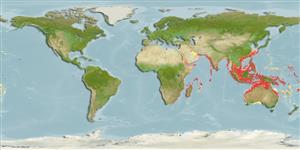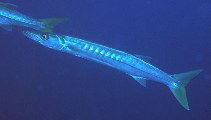Ajouter votre observation dans Fish Watcher
| Native range | All suitable habitat | Point map | Year 2050 |

|
| This map was computer-generated and has not yet been reviewed. |
| Sphyraena jello AquaMaps Data sources: GBIF OBIS |
Saudi Arabia country information
Common names:
Agam, Edwailmy
Occurrence: native
Salinity: marine
Abundance: | Ref:
Importance: | Ref:
Aquaculture: | Ref:
Regulations: | Ref:
Uses: no uses
Comments:
National Checklist:
Country Information: https://www.cia.gov/library/publications/resources/the-world-factbook/geos/sa.html
National Fisheries Authority:
Occurrences: Occurrences Point map
Main Ref: Rose, J.H., 1984
National Database:
Occurrence: native
Salinity: marine
Abundance: | Ref:
Importance: | Ref:
Aquaculture: | Ref:
Regulations: | Ref:
Uses: no uses
Comments:
National Checklist:
Country Information: https://www.cia.gov/library/publications/resources/the-world-factbook/geos/sa.html
National Fisheries Authority:
Occurrences: Occurrences Point map
Main Ref: Rose, J.H., 1984
National Database:
Common names from other countries
Classification / Names Noms communs | Synonymes | Catalog of Fishes(Genre, Espèce) | ITIS | CoL | WoRMS | Cloffa
> Carangaria/misc (Various families in series Carangaria) > Sphyraenidae (Barracudas)
Etymology: Sphyraena: Greek, sphyraina, -es = the name of a fish (Ref. 45335).
More on author: Cuvier.
Etymology: Sphyraena: Greek, sphyraina, -es = the name of a fish (Ref. 45335).
More on author: Cuvier.
Environment: milieu / climate zone / depth range / distribution range Écologie
marin; saumâtre récifal; océanodrome (Ref. 51243); profondeur 20 - 200 m (Ref. 28016), usually ? - 60 m (Ref. 90102). Tropical; 27°N - 37°S, 29°E - 152°E
Distribution Pays | Zones FAO | Écosystèmes | Occurrences | Point map | Introductions | Faunafri
Indo-West Pacific: Red Sea (Ref. 12541) south to the southeastern coast of South Africa and east to New Caledonia and Vanuatu. Recently reported from Tonga (Ref. 53797). Due to a widespread confusion with Sphyraena putnamae and Sphyraena qenie, the exact range is uncertain.
Taille / Poids / Âge
Maturity: Lm ? range ? - ? cm
Max length : 150 cm TL mâle / non sexé; (Ref. 2871); common length : 120 cm TL mâle / non sexé; (Ref. 5450); poids max. publié: 11.5 kg (Ref. 40637)
Max length : 150 cm TL mâle / non sexé; (Ref. 2871); common length : 120 cm TL mâle / non sexé; (Ref. 5450); poids max. publié: 11.5 kg (Ref. 40637)
Description synthétique Clés d'identification | Morphologie | Morphométrie
Épines dorsales (Total) : 6; Rayons mous dorsaux (Total) : 9; Épines anales: 2; Rayons mous anaux: 7 - 9. Body with dark bars crossing lateral line, each bar oblique in upper half, but nearly vertical in lower half; caudal fin largely yellowish.
Found near prominent current-swept lagoon or seaward reefs (Ref. 9710); also in bays, estuaries and turbid inner lagoons (Ref. 9768). Diurnal and solitary, although the young form schools. Feeds mainly on fishes but also takes squid. Sold fresh, frozen or dried salted. Reports of ciguatera poisoning need confirmation.
Life cycle and mating behavior Maturité | Reproduction | Frai | Œufs | Fécondité | Larves
Référence principale
Upload your references | Références | Coordinateur | Collaborateurs
De Sylva, D.P. and F. Williams, 1986. Sphyraenidae. p. 721-726. In M.M. Smith and P.C. Heemstra (eds.) Smiths' sea fishes. Springer-Verlag, Berlin. (Ref. 5491)
Statut dans la liste rouge de l'IUCN (Ref. 130435: Version 2024-2)
Préoccupation mineure (LC) ; Date assessed: 14 August 2023
Utilisations par l'homme
Pêcheries: commercial; pêche sportive: oui
FAO(pêcheries: production; publication : search) | FishSource | Sea Around Us
Plus d'informations
Trophic ecology
Éléments du régime alimentaire
Composition du régime alimentaire
Consommation alimentaire
Food rations
Prédateurs
Éléments du régime alimentaire
Composition du régime alimentaire
Consommation alimentaire
Food rations
Prédateurs
Population dynamics
Paramètres de croissance
Max. ages / sizes
Length-weight rel.
Length-length rel.
Fréquences de longueurs
Mass conversion
Recrutement
Abondance
Paramètres de croissance
Max. ages / sizes
Length-weight rel.
Length-length rel.
Fréquences de longueurs
Mass conversion
Recrutement
Abondance
Life cycle
Reproduction
Maturité
Fécondité
Frai
Spawning aggregations
Œufs
Développement de l'œuf
Larves
Dynamique des populations larvaires
Reproduction
Maturité
Fécondité
Frai
Spawning aggregations
Œufs
Développement de l'œuf
Larves
Dynamique des populations larvaires
Physiology
Body composition
Nutrients
Consommation d'oxygène
Type de nage
Vitesse de nage
Visual pigments
Fish sound
Diseases & Parasites
Toxicity (LC50s)
Body composition
Nutrients
Consommation d'oxygène
Type de nage
Vitesse de nage
Visual pigments
Fish sound
Diseases & Parasites
Toxicity (LC50s)
Genetics
Génétique
Heterozygosity
Héritabilité
Génétique
Heterozygosity
Héritabilité
Human related
Aquaculture systems
Profils d'aquaculture
Souches
Ciguatera cases
Stamps, coins, misc.
Aquaculture systems
Profils d'aquaculture
Souches
Ciguatera cases
Stamps, coins, misc.
Outils
Bio-Quiz | E-book | Guide de terrain | Clés d'identification | Générateur de fréquences de longueur | Outil de dynamique de population | Carte par point | Classification Tree
| Catch-MSY |
Articles particuliers
Télécharger en XML
Sources Internet
Aquatic Commons | BHL | Cloffa | BOLDSystems | Websites from users | FishWatcher | CISTI | Catalog of Fishes(Genre, Espèce) | DiscoverLife | ECOTOX | Faunafri | Fishtrace | GenBank(génôme, nucléotide) | GloBI | GOBASE | | Google Books | Google Scholar | Google | IGFA World Record | MitoFish | Bases de données nationales | Otolith Atlas of Taiwan Fishes | PubMed | Reef Life Survey | Scirus | SeaLifeBase | Arbre de Vie | Wikipedia(aller à, chercher) | World Records Freshwater Fishing | Zoobank | Zoological Record
Estimates based on models
Preferred temperature (Ref. 115969): 23.6 - 28.5, mean 27.3 (based on 442 cells).
Phylogenetic diversity index (Ref. 82804): PD50 = 0.5000 [Uniqueness, from 0.5 = low to 2.0 = high].
Bayesian length-weight: a=0.00724 (0.00608 - 0.00863), b=2.92 (2.88 - 2.96), in cm Total Length, based on LWR estimates for this species (Ref. 93245).
Niveau trophique (Ref. 69278): 4.5 ±0.6 se; based on diet studies.
Résilience (Ref. 120179): Faible, temps minimum de doublement de population : 4,5 à 14 années (K=0.10).
Fishing Vulnerability (Ref. 59153): Very high vulnerability (75 of 100).
Climate Vulnerability (Ref. 125649): High to very high vulnerability (73 of 100).




